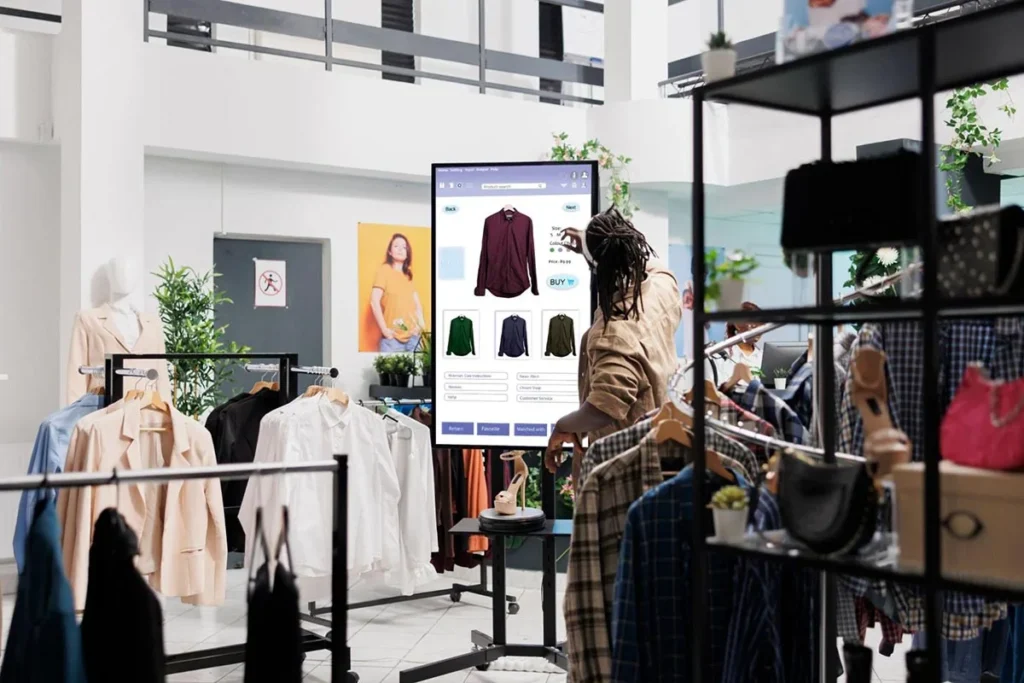How to create the best business ads
Of the $287 billion advertising dollars spent in the U.S. in 2022, over $154 billion of it was spent on mobile ads. But that doesn’t mean traditional advertising platforms like TV, direct mail, and newspapers should be dismissed. Small business owners should be familiar with all types of ad formats to see which ones work best for their business.
Whether you run a local business or an e-commerce shop, the best business ads for you will depend on your target audience and marketing budget.

Learn about the best advertising platforms for small businesses and what type of ads are most effective for reaching more customers.
What are the different types of business ads?
Modern ad campaigns range from traditional newspaper ads to programmatic ads that use artificial intelligence to determine where your ad is placed. Your business doesn’t need to invest in all of these ad formats, and in fact, even trying to do so would likely stretch your marketing budget too thin.
Consider trying one or two digital advertising strategies and one or two traditional ad campaigns. Over time, you’ll learn what advertising works best for you. Here are 10 different types of business ads to consider.
Print advertising refers to ads in newspapers, magazines, and other printed material. It was once the leading form of small business advertising, but now that most Americans read the news online, it’s no longer the most effective advertising option.
Still, for local businesses, it may be worth placing a print ad in a local newspaper every once in a while to reach potential customers in your area. Brands can also get media exposure by appearing in industry newsletters, print catalogs, and even in-flight magazines.
Broadcast
Broadcast advertising has traditionally referred to ads that air on media platforms like TV and the radio, and it has now expanded to other avenues like podcast streams. For small businesses with a great audio advertising idea, podcast advertising may be the way to go—some 76 million people (23%) of Americans listen to podcasts regularly.
Television ads still account for 40% of ad spending in the U.S., but the cost of producing and airing a TV ad can be prohibitive for small businesses.
Radio ads have a lower barrier to entry, but the decline of radio as a medium means it may not offer the best return on investment (ROI).
Direct mail
Direct mail may seem old-fashioned, but it still offers a great ROI—as much as 43%. Direct mail includes everything from catalogs and brochures that advertise multiple businesses to targeted ad campaigns managed directly by your team.
For restaurants and other local businesses that don’t have a large online presence, direct mail can be a worthwhile outbound lead generation strategy.
Billboards
Billboards are hard to miss, making them a reliable business advertising idea, even in the digital age. Billboard ads cost around $850 for a four-week placement, but you can expect to pay higher rates for this type of outdoor advertising in major metropolitan areas or at busy intersections.
Other forms of out-of-home advertising include ads on buses or at public transit stops and signage at sports stadiums and other entertainment venues.
Search engine and business platform advertising
Moving on to digital advertising examples, there’s search engine advertising, which is a way of reaching new customers based on the terms they’re searching for online. Search engine ads appear on search engine results pages (SERPs) alongside organic (non-paid) search results, usually on a pay-per-click basis.
Google Ads is the most well-known search engine advertising platform, but potential customers may be searching for relevant keywords on other platforms as well. For example, customers are searching on Yelp to find new businesses of various kinds, and 8 out of 10 searches on Yelp don’t include a specific business name.
When you invest in Yelp Ads, your business page is placed in key places on Yelp.com and the Yelp mobile app, such as above or below relevant search results and on your competitors’ pages. You can set a daily ad spend of as little as $5 on average and pause or cancel your campaign at any time.
Get more leads
Reach more customers with placements on search and competitors' pages.

Social media advertising
Social media marketing involves posting content to social media channels to reach new customers and build brand awareness. Social media advertising specifically refers to paid ads that appear on these platforms, often alongside user-generated content.
You can either post free content to your own account or pay to display ads to a wider audience using Facebook Ads or another social media platform.
The best social network to advertise on will depend on your advertising budget and the specific audience you want to reach. LinkedIn, TikTok, and Facebook advertising tools all cater to different demographics and have their own ad formats.
Video ads
Video ads can appear on a wide range of online platforms. In the U.S., streaming sites, such as YouTube and Hulu, accounted for the most digital ad impressions in 2023, followed by programmatic ads that can appear everywhere from mobile devices to smart TVs based on specific circumstances or triggers. For example, IBM describes a coffee brand that used programmatic advertising to “target customers when their local weather was colder or warmer than usual” by delivering ads based on current weather conditions.
You can stick with a traditional video ad where you create a 30-second video clip to promote your small business or advertise a new product. Or use video ads as a type of content marketing by creating helpful how-to videos or product guides.
Mobile ads
This type of advertising in business includes many of the above digital ad formats, but with a focus on mobile devices. Mobile ads include everything from ads that pop up between video game levels to ads that encourage customers to download your mobile app.
Mobile advertising may also refer to SMS advertising where you contact customers directly via text. Like email marketing, you should only market to customers who have opted in to your list to ensure compliance with legal regulations.
Native ads
Native ads are designed to look just like organic content so they don’t break the flow when a customer is scrolling their social media feed or reading a news website. This type of advertising includes “sponsored content” and “branded journalism” and may include some types of influencer campaigns as well.
Native ads need to contain a disclosure statement to avoid misleading anyone, but when done right, this can be a cost-effective way to build brand loyalty.
Product placement
Product placement is the age-old practice of getting your product to appear in a movie or TV show in the hope that greater visibility will increase sales. These days, product placement in video games may be the next frontier.
Although it can be expensive, small businesses owners can get creative with product placement ideas. For example, a local retailer might strike a deal to have their brand mentioned in a TV show by letting the crew use their store as a filming location.
Best business ad strategies and design principles

Deciding on a marketing campaign and the specific ad types you want to pursue is an important first step. Then once you’ve identified your target audience and developed a plan, it’s time to design your ads. Here are six ad strategies and design principles to keep in mind.
Keep it simple
First, keep it simple. It might be tempting to tell potential customers about all of your products on the first go, but ads with a concise message and a single call-to-action perform better than ads that try to do everything at once.
Consider launching an initial ad campaign to build brand awareness and another campaign for each major launch of a new product or service.
The same goes for the visual appearance of your ad: If there’s too much text or the ad appears cluttered, viewers won’t be able to read it easily. If you really need to display multiple products or ideas in the same ad, create carousel ads that allow viewers to scroll between multiple image cards at their own pace.
Stay on brand
The best business ads show off your brand’s personality while aligning with your brand values. Avoid partnerships with other brands or influencers whose values conflict with yours, and don’t change your image too much between campaigns.
It’s good to be creative, but stick with a consistent small business logo, font, and brand voice so your target customers can get to know your brand over time.
Get the specs right
Mobile ads, banner ads, and other digital ads all have their own technical specifications. According to Creatopy, display ads are usually 300 x 250 pixels, but this can vary from one platform to the next. Downloadable ads tend to be HTML, GIFs, or JPEGs.
Resize and reform your ad for each platform so it looks as good as it possibly can. Even high-quality ads can appear stretched, blurry, or pixelated in the wrong format.
Hire professionals
Most of the steps in online advertising are easy to learn, but not every small business owner knows how to write taglines or take good product photos.
Set some money aside in your advertising budget to hire professionals when you need them. A professional copywriter or graphic designer can look over your brand assets and help you create the best business ad within your timeline and budget.
Make an emotional connection
The best business ads make a connection with customers that goes above and beyond introducing your brand or showing off your new product or service. Do you want to inspire them? Intrigue them? Reassure them that you have the solution to their needs?
Think about what types of emotions you can evoke in your ad campaigns—try forming an authentic connection with your audience to build loyal customers.
Highlight your reputation
When you launch a new ad campaign, you only have a brief moment to get customers interested and earn their trust. Consider including snippets of customer reviews, awards or endorsements, or how many years of experience you have to help you make a strong first impression.
Yelp tip: When you create an ad on Yelp, you can use a customer review as your ad copy to attract future clients. Or you can write your own copy to highlight the best parts of your business’s reputation.
Regardless of how you highlight your reputation in your ad specifically, be sure your overall online presence is in good shape—users who are intrigued by your ad will likely do more research on your business. Build your online reputation by maintaining accurate information across your website and all online platforms, responding to all customer feedback and reviews, and staying active on your social media channels.
Small business marketing tips and best practices

Once your business ads are up and running, follow these tips to make the most of your newfound exposure and get the best possible return on your investment.
Get free exposure online
Most businesses have to pay for at least some of their online advertising. But there are plenty of places to get free publicity, including online business platforms like Yelp.
Add or claim your Yelp Business Page to get your brand in front of customers who are searching for a specific product or service on Yelp. Then be sure your page is filled out: Businesses with a photo, website, phone number, and business hours listed on their Yelp Business Page averaged 7.6x more page views per month than businesses without that content.
If you want to generate more leads quickly, consider investing in Yelp Ads—businesses that use Yelp Ads get 2.5 more leads on average. You can also make a strong impression on those who visit your page by investing in the Upgrade Package, which offers special badges, additional photo options, and a Call-to-Action tool.
Get found for free
Show up for any of the millions of customers on Yelp searching for a business like yours.

Know your audience
Some businesses make the mistake of casting a wide net and marketing to customers who aren’t a great match for their business. To be successful, you don’t need to reach every single person—just potential customers who are most likely to take a desired action.
By focusing your marketing efforts on a specific demographic or geographic region, you’ll spend less money overall but increase your ROI.
This could take the form of local lead generation strategies or an emphasis on certain social media platforms over others.
Team up with influencers
The concept of influencer marketing might bring to mind major brands shelling out big bucks to the latest TikTok celebrities. However, you don’t need to team up with the biggest social media stars to benefit from influencer marketing.
In fact, according to some industry reports, “micro-influencers” are a safer bet than “macro-influencers” because they have a smaller, more dedicated fan base.
Instead of spending your entire budget on a macro-influencer, work with multiple micro-influencers to reach more demographics or target a niche audience.
Create an email list
With email advertising—usually referred to as email marketing—you develop an email list so you can advertise products or services directly to customers. Since subscribers have to opt-in to your mailing list, it can take time to build an email list compared to other digital marketing strategies. But once you do, that list is yours to keep.
You can use lead magnets (which are free incentives in exchange for a customer’s contact information) and other content marketing ideas to get new subscribers, then use A/B testing and market segmentation to create the best business ads and optimize your conversion rate.
Use A/B testing
A/B testing is the practice of using multiple variations of a campaign to see which one is most effective at converting customers. You can use this strategy on email marketing campaigns, slogans, taglines, product descriptions, and more.
Let’s say you want to try out a new marketing slogan on your email list. One half gets an email with your new slogan in the subject line and the other half gets an email with the same old slogan. Which of the two campaigns has a higher open rate?
The main requirement for A/B testing is a large enough sample size and access to ad data, such as your click-through rate or conversion rate. When done right, A/B testing can be a great way to try out new digital advertising ideas and optimize your tagline, call-to-action, and even the photos you display in your ads.
Get creative with timing
There’s one more variable to play with, and that’s timing. While traditional billboard ads may lock you into a four-week campaign, digital advertising is more flexible. If you can’t afford to keep your ads running year round, pause them. When business is slow, bump up your ad spend to generate new leads quickly.
Yelp tip: With Yelp Ads, you can pause or adjust your ad spend at any time, and set a daily ad spend so you don’t have to worry about exceeding your advertising budget.
Time your advertising campaigns to coincide with seasonal deals or experiment with advertising on different days of the week. Find free ways to advertise your business online to maintain brand awareness during the off-season.
Create the best business ads for your brand

The best online advertising for small businesses comes down to your industry, budget, and brand personality. Traditional advertising options include billboards and direct mail while digital advertising encompasses everything from social media ads to influencer marketing campaigns.
Whether you choose to advertise online or offline, ensure that your ad design fits the requirements of the ad platform and hire professionals if you need help with graphic design or copywriting.
With Yelp Ads, you can create new ads quickly and easily using information from your Yelp Business Page or drawing from customer reviews. When you choose the Upgrade Package on Yelp, you’ll get additional photo options and a Call-to-Action tool. You can also prevent competitor ads from appearing on your page at all.
To get in front of even more customers in a cost-effective way, check out 34 free and low-cost advertising ideas.